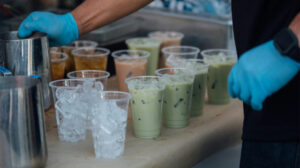Bubble tea, or as it is more commonly known boba tea, has had an impressive journey from the early 1980s to its current global success. Once seen as an innovative idea, the beverage has now become a symbol of modern coffee and tea culture, bridging cultures and tastes from all corners of the world.
Instagram users have adopted bubble tea as a new trend, often posting, photos and videos of strikingly colored drinks. Hashtags such as #BubbleTea, #BobaTea, and #Boba have become extremely popular, garnering millions of posts showing the variety of boba options.
The trend has also been amplified by influencers and food bloggers showcasing new drinks, recipes, and flavor variations of boba tea. Boba Tea’s presence on Instagram has sparked an ongoing demand for new and interesting flavors, as consumers want to try the latest trends and share their experiences with their followers. This interaction process has contributed to the global spread of bubble tea, making it not only a delicious beverage but also a cultural phenomenon that is connected to modern lifestyles.
The history of boba tea goes back to Chui Shui Tang, a traditional tea shop that opened in Taiwan in the 1980s. Its founder, Liu Han-Chieh, initially faced serious challenges in trying to sell tea leaves in a highly demanding and traditional space. As Liu admits, selling tea was more complicated than he imagined. Customers preferred to chat for hours about tea without making final purchases, which made the business difficult.
Until the invention of iced tea marked the first major turning point for Chui Shui Tang. Inspired by the iced coffee he tasted on a trip to Japan, Liu decided to create an iced tea. The result was spectacular: the iced tea quickly gained public trust, outselling traditional hot teas and reaching a wider customer base, from young children to the elderly.
Liu’s next innovative move came when Lin Hsiu-hui, a young employee, decided to add chewy tapioca balls to her iced tea. These balls, reminiscent of black pearls, quickly became the trademark of the beverage. The new creation blended with the traditional taste of the tea, offering a unique and delightful experience that began to win hearts beyond Taiwan’s borders.
Liu Han-Chieh’s family plays an important role in the history of boba tea. The founder of Chui Shui Tang, comes from a family of doctors. Liu’s father was initially not supportive of Liu’s decision to introduce innovative ideas into his tea shop. In particular, the addition of iced tea infuriated his father.
According to Liu, when his father found out about the changes he was making to the business, he didn’t speak to him for three years. However, Chui Shui Tang’s success and impressive sales eventually convinced him to acknowledge his son’s success.
As BusinessInsider reports, Chui Shui Tang was not the only shop to claim the invention of boba tea. The Hanlin Tea Room in southern Taiwan, run by Tu Tsung-ho, also claims to have invented the beverage around the same time. The ensuing legal battle between the two companies, although it did not result in a formal ruling, has put the issue of the paternity of boba tea up for debate.
Today, the Chun Shui Tang chain has over 200 stores around the world. In the US, figures show a significant increase in tapioca exports, indicative of the beverage’s popularity. Liu’s daughter, Angela, CEO of Chun Shui Tang, is seeking to expand the chain internationally, inspired by her father’s ambition to establish the company as a global brand. Despite growing global demand and fierce competition, Chun Shui Tang has not been in a rush to expand aggressively, opting to pursue a long-term growth strategy.
Although the company still has a long way to go to reach Starbucks’ heights, family heritage and management play a key role in its continued growth. Liu Han-Chieh remains optimistic, seeing competitors as an opportunity to increase boba tea’s global brand awareness. With a solid foundation and a strong market presence, Chun Shui Tang continues to invest in creating new innovations, highlighting boba tea as a beverage that is not just a trend, but a new era in the art of tea.
Ask me anything
Explore related questions





